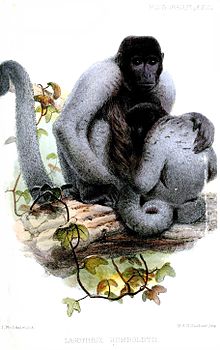Woolly monkey
| Woolly monkeys | |
|---|---|
 |
|
| L. lagotricha | |
| Scientific classification | |
| Kingdom: | Animalia |
| Phylum: | Chordata |
| Class: | Mammalia |
| Order: | Primates |
| Family: | Atelidae |
| Subfamily: | Atelinae |
| Genus: |
Lagothrix É. Geoffroy, 1812 |
| Type species | |
|
Simia lagotricha Humboldt, 1812 |
|
| Species | |
|
Lagothrix lagotricha |
|
Lagothrix lagotricha
Lagothrix cana
Lagothrix lugens
Lagothrix poeppigii
The woolly monkeys are the genus Lagothrix of New World monkeys, usually placed in the family Atelidae.
The four species of woolly monkeys all originate from the rainforests of South America. They have prehensile tails and live in relatively large social groups.
One species of woolly monkey, the yellow-tailed woolly monkey, has recently been placed in the genus Oreonax.
Woolly monkeys have coat colour variations including dark brown, red-brown, gray, and olive. Their back sides are usually lighter in color than their underbelly sides. They have black faces, and the palms of their hands are a deep pink color. Their tails are long and thick and are strong enough to support the animals' full body weight. The species' prehensile tail grips on tight to branches, acting as a fifth limb and enabling the animal to forage while hanging on to a branch with its tail. Woolly monkeys weigh an average of 17 lb (7.7 kg), though males are substantially larger than females.
Woolly monkeys are found throughout the northern countries of South America (Bolivia, Brazil, Colombia, Ecuador, Venezuela, and Peru). They usually reside in high-elevation cloud forests, seasonally flooded rainforests, and forests which are situated within Colombia's eastern plains region, although their ideal habitat is humid and mature tropical forests.
The species lives in social groups ranging from 10 to 45 individuals. Foraging groups, however, tend to consist of two to six individuals which branch out from the main group, which is probably intended to reduce food competition between individuals. Woolly monkey diets consist of fruit with an addition of leaves, seeds, flowers, and invertebrates. Each group is governed and led by an alpha male, and the social organization within a larger group is organized by age, sex, and the reproductive status of females. Reproduction in these groups is characterized by promiscuity; one male (either the alpha or subordinate) mates with more than one female, just as females mate with more than one male. Shortly after the females reach maturity, they leave their natal groups to avoid any occurrence of inbreeding, while males tend to remain in their natal groups.
...
Wikipedia
